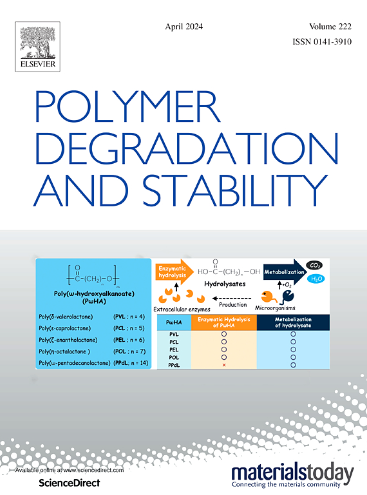降解-重建-功能增强耦合再生PET成P-N协同阻燃的再生热塑性聚氨酯
IF 7.4
2区 化学
Q1 POLYMER SCIENCE
引用次数: 0
摘要
废塑料的功能性再生是实现可持续发展的关键战略。本研究开发了一种功能性和协同升级回收废旧PET的方法。利用化学醇解和共聚技术,对废旧PET进行化学改性,制备阻燃聚酯多元醇(rFR POL)。然后将其用作功能性软段进行聚合,从而合成可回收的高透明度,耐候性和阻燃性热塑性聚氨酯(rFR TPU)。研究表明,在TPU生产中,使用rFR POL作为软段可以减少57%的石油基材料的使用。这提高了TPU薄膜的透明度、耐水解性和阻燃性。经过14天的水解和热失重测试,发现rfr50% TPU的分子量几乎没有变化,在225℃时具有很高的T5wt %。对于rfr100% TPU,磷含量增加到19680 ppm, LOI达到35.30%,垂直燃烧额定V-0。其阻燃机理归因于磷- n的气相和凝聚相协同阻燃作用。该工艺的总GWP为2800 kg CO2当量,总成本为每吨1342美元,分别比传统的石油基TPU生产低37.8%和42%。该工艺降低了聚酯的火灾风险,从根本上解决了功能链迁移和改性剂过量的问题。它还实现了不可生物降解聚酯的升级回收,为绿色阻燃聚合物的开发提供了创新的解决方案。本文章由计算机程序翻译,如有差异,请以英文原文为准。

Degradation-reconstruction-functional enhancement coupled upcycling of waste PET into recycled thermoplastic polyurethane with P-N synergistic flame retardancy
Functional regeneration of waste plastics is a pivotal strategy for sustainable development. This study has developed a method for functional and collaborative upgrading recycling of waste PET. By using chemical alcoholysis and copolymerization techniques, the waste PET is chemically modified into flame-retardant polyester polyols (rFR POL). It is then used as functional soft segments to polymerize, resulting in the synthesis of recycled high transparency, weather-resistant, and flame-retardant thermoplastic polyurethane (rFR TPU). Research shows using rFR POL as a soft segment cuts petroleum-based material use by 57 % in TPU production. And this enhances the transparency, hydrolysis resistance and flame retardancy of TPU films. After 14 days of hydrolysis and thermal weight loss tests, it was found that the molecular weight of rFR50 % TPU remains almost unchanged, with a high T5wt % (225 °C). For rFR100 % TPU, the phosphorus content increases to 19,680 ppm, the LOI reaches 35.30 %, and the vertical burning is rated V-0. The flame retardancy mechanism is attributed to the synergistic gas phase and condensed phase flame retardant effects of P-N. The total GWP of this process is 2800 kg CO2 equivalent, and the total cost is $1342 per ton, which is 37.8 % and 42 % lower than traditional petroleum-based TPU production, respectively. This process reduces polyester fire risks, fundamentally solves functional chain migration and excessive modifier issues. It also achieves upgraded recycling of non-biodegradable polyester, providing an innovative solution for green flame-retardant polymer development.
求助全文
通过发布文献求助,成功后即可免费获取论文全文。
去求助
来源期刊

Polymer Degradation and Stability
化学-高分子科学
CiteScore
10.10
自引率
10.20%
发文量
325
审稿时长
23 days
期刊介绍:
Polymer Degradation and Stability deals with the degradation reactions and their control which are a major preoccupation of practitioners of the many and diverse aspects of modern polymer technology.
Deteriorative reactions occur during processing, when polymers are subjected to heat, oxygen and mechanical stress, and during the useful life of the materials when oxygen and sunlight are the most important degradative agencies. In more specialised applications, degradation may be induced by high energy radiation, ozone, atmospheric pollutants, mechanical stress, biological action, hydrolysis and many other influences. The mechanisms of these reactions and stabilisation processes must be understood if the technology and application of polymers are to continue to advance. The reporting of investigations of this kind is therefore a major function of this journal.
However there are also new developments in polymer technology in which degradation processes find positive applications. For example, photodegradable plastics are now available, the recycling of polymeric products will become increasingly important, degradation and combustion studies are involved in the definition of the fire hazards which are associated with polymeric materials and the microelectronics industry is vitally dependent upon polymer degradation in the manufacture of its circuitry. Polymer properties may also be improved by processes like curing and grafting, the chemistry of which can be closely related to that which causes physical deterioration in other circumstances.
 求助内容:
求助内容: 应助结果提醒方式:
应助结果提醒方式:


